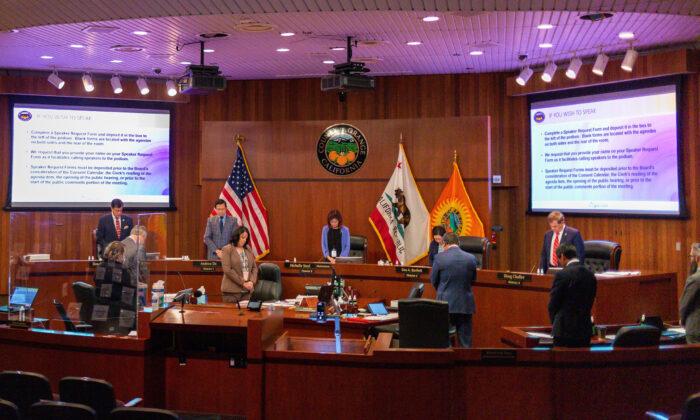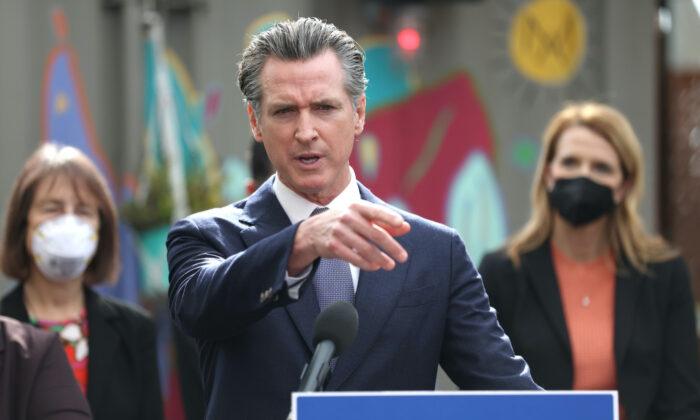The Orange County Board of Supervisors voted to continue local health emergency declarations related to the COVID-19 pandemic at a Nov. 3 meeting in Santa Ana, California, despite the vocal opposition of some members of the public.
The county had been set to revisit the declarations again on Dec. 8, but officials moved up the date to Nov. 17.
“Remember a time when there was freedom? Remember a time when our businesses flourished and people had personal liberty to make decisions for themselves and their families? What has happened to that America?” asked a woman from Irvine, who called herself Enya.
Said Victoria from Tustin, “Emergency powers do not excuse violations of inalienable rights. … Public officials are not immune from suit when they transcend their lawful authority by invading constitutional rights.”
In the ruling, Heckman said Newsom overstepped his authority with an executive order in June ordering all counties in the state to send mail-in ballots to every registered voter for the November election. She also blocked Newsom “from exercising any power under the California Emergency Services Act which amends, alters, or changes existing statutory law, or makes new statutory law or legislative policy.”
At the meeting, Michelle Steel, chairwoman of the Board of Supervisors, questioned the county counsel, Leon Page, about the lawsuit.
“Is that going to change anything about [how] the governor’s almost like a dictatorship? And he is just pushing all of these policies without any scientific base. How is it going to change?” she asked.
Page said since the decision was tentative, it’s not yet final or binding, and the judge could still change her mind. He said if it becomes final, the governor will likely appeal the decision.
The decision also doesn’t change anything right now for Orange County, he said.
“There is no impact on Orange County. There’s no impact on our Registrar of Voters, no impact on today’s election, but it is a very interesting case, and it’s one that we’ll be paying very close attention to as the case proceeds,” Page said.
Orange County CEO Frank Kim said the county has been working with several groups, including the California State Association of Counties, to gather data and other information regarding a recent rise in COVID-19 case rates, and the impact the uptick had on hospitalizations and deaths in individual counties.
He hoped the discussion would help the state change its policies to more closely match the interests of the counties.
“[We’re] trying to identify what the relationship has been in this kind of second mild wave that we have seen in California and using that data to then develop discussion points with the administration about what this new rise in case rates means in terms of the risk to our community,” Kim said.
However, there’s currently no estimate on when they will get a response from the state, he said.
Orange County is still solidly in the red tier, or “substantial” risk level, of California’s Blueprint for a Safer Economy, the state’s COVID-19 monitoring system, meaning there are still many significant restrictions on local businesses.
Although the county’s test positivity rate is within the range of the orange tier, or “moderate” risk level, the case rate per 100,000 and health equity quartile positivity rate are still within the red tier’s range.
As of Nov. 3, Orange County’s test positivity rate is 3.2 percent, while the case rate is 5.1 per 100,000 and the health equity metric is 6 percent. To move to the orange tier, the case rate must be below 4 new daily cases per 100,000 people, and the health equity metric must be below 5.3 percent. The overall test positivity rate must also remain below 5 percent.
California typically updates the county data on Tuesdays, but it will be delayed until Wednesday, Nov. 4, this week due to the election.
The Orange County Health Care Agency on Nov. 3 reported 306 new cases of COVID-19 and one additional fatality, for a total of 60,604 confirmed cases and 1,484 deaths. There are now 177 people hospitalized, including 60 in intensive care.
The number of hospitalizations had previously fallen to 159 on Oct. 23, with only 55 people in intensive care, before a recent uptick in cases.





